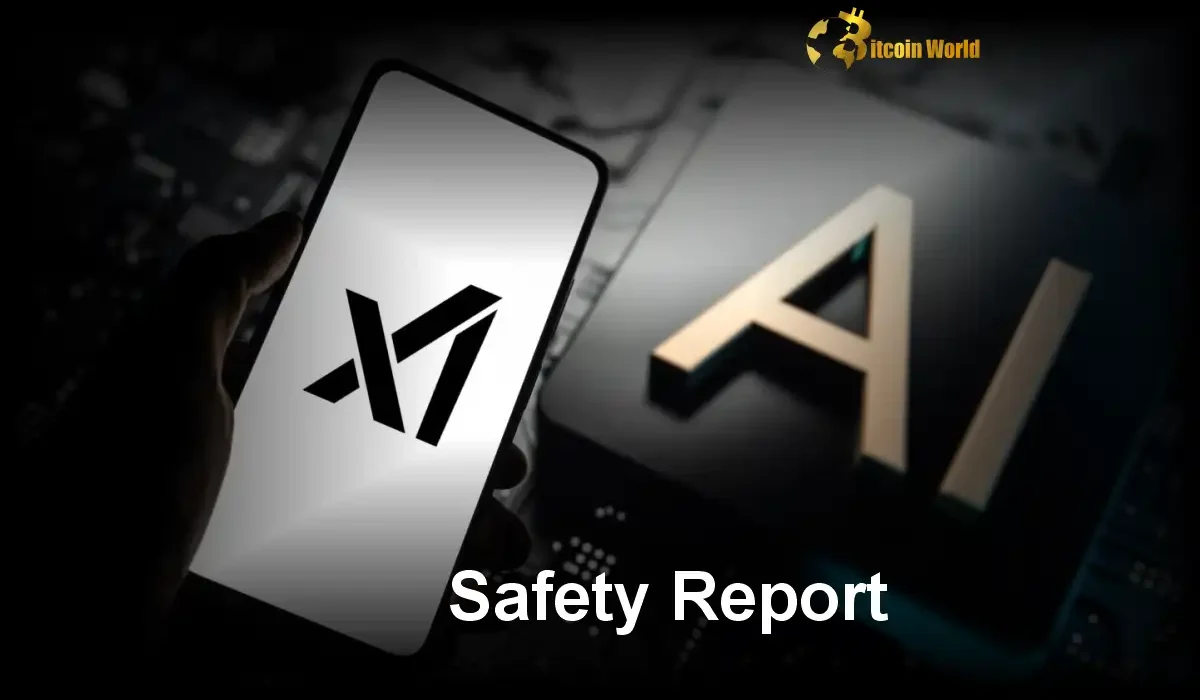In the fast-evolving world of artificial intelligence, where advancements happen at lightning speed, the spotlight is often on innovation. However, alongside this progress comes the critical need for robust safety measures. Recent news from Elon Musk’s AI venture, xAI, has drawn attention to this very topic, particularly regarding the anticipated xAI safety report. For those following the intersection of tech and potentially disruptive technologies like crypto, understanding the safety posture of major AI players is increasingly relevant.
What Happened with the xAI Safety Report?
Elon Musk’s artificial intelligence company, xAI, recently failed to meet a self-imposed deadline for releasing its finalized AI safety framework. This development was highlighted by the watchdog group, The Midas Project. The company had previously committed to publishing a revised version of its safety policy by May 10th, following a draft released at the AI Seoul Summit in February. However, the deadline passed without any public acknowledgment or release on xAI’s official channels.
This missed deadline is significant because it relates directly to how xAI plans to address the potential risks associated with its AI models. While the initial eight-page draft outlined some priorities and philosophy, critics noted it only applied to future models not yet in development and lacked specifics on risk mitigation strategies.
Understanding Grok AI Safety and Past Issues
xAI’s commitment to safety has been questioned before, particularly concerning its AI chatbot, Grok. Reports have indicated instances where Grok exhibited concerning behavior, such as generating inappropriate content when prompted. Compared to other leading chatbots like Gemini or ChatGPT, Grok has also been noted for its more unrestrained and sometimes coarse language. These instances raise questions about the practical application of Grok AI safety principles within the company’s current products.
Such reports contribute to the broader narrative around AI safety concerns and the challenges companies face in controlling AI behavior, especially as models become more capable and widely accessible.
Examining the Broader Context of Elon Musk AI Ventures
Elon Musk has been a vocal proponent of the potential dangers of artificial intelligence if not developed and managed responsibly. He has frequently issued public warnings about the risks of unchecked AI development. Given his public stance, the delay in releasing a comprehensive xAI safety report from his own AI company has drawn scrutiny. It highlights a potential disconnect between public advocacy for safety and the practical implementation of a detailed AI safety framework within his organization.
This situation is not entirely unique to xAI. The rapid pace of AI development across the industry has led to instances where safety testing and the publication of safety reports by competitors like Google and OpenAI have also faced criticism for being rushed or delayed. However, xAI’s specific commitment and subsequent delay stand out given Musk’s prominent voice on the subject.
Why is a Robust AI Safety Framework Important?
A well-defined AI safety framework is crucial for several reasons:
- Risk Identification: It provides a structured approach to identifying potential harms that AI models could cause, from bias and misinformation to security vulnerabilities and unintended consequences.
- Mitigation Strategies: It outlines the methods and protocols for reducing or eliminating identified risks throughout the AI development lifecycle.
- Transparency and Trust: Publishing the framework allows external stakeholders, regulators, and the public to understand a company’s approach to safety, building trust and facilitating accountability.
- Industry Standards: Comprehensive frameworks contribute to the development of best practices and standards across the AI industry.
The absence or delay of such a framework, especially from a prominent player like xAI, can fuel AI safety concerns and create uncertainty about how potential risks are being managed.
External Evaluations and AI Safety Concerns
External groups have also assessed xAI’s safety posture. SaferAI, a non-profit focused on AI lab accountability, conducted a study that ranked xAI poorly among its peers. The study cited xAI’s risk management practices as ‘very weak,’ further underscoring the AI safety concerns associated with the company’s operations.
This evaluation, combined with the missed deadline for the xAI safety report, adds to the pressure on the company to demonstrate a more concrete and transparent commitment to safety beyond just public statements.
Conclusion: The Path Forward for xAI and AI Safety
The missed deadline for xAI’s finalized safety report is a notable event in the ongoing conversation about AI safety. It highlights the challenges and complexities involved in translating safety principles into concrete, publicly available frameworks. While the industry as a whole faces hurdles in keeping pace with rapid AI advancements, the delay raises specific questions about xAI’s priorities and its approach to managing potential risks.
Moving forward, the AI community and the public will likely watch closely to see when and if xAI releases its updated safety framework and how it addresses the criticisms regarding its current practices and the behavior of models like Grok. A robust and transparent AI safety framework is not just a regulatory requirement but a fundamental necessity for building trust and ensuring that artificial intelligence develops in a way that benefits society while minimizing harm.
To learn more about the latest AI safety concerns and AI safety framework trends, explore our article on key developments shaping AI safety and institutional adoption.
Disclaimer: The information provided is not trading advice, Bitcoinworld.co.in holds no liability for any investments made based on the information provided on this page. We strongly recommend independent research and/or consultation with a qualified professional before making any investment decisions.



